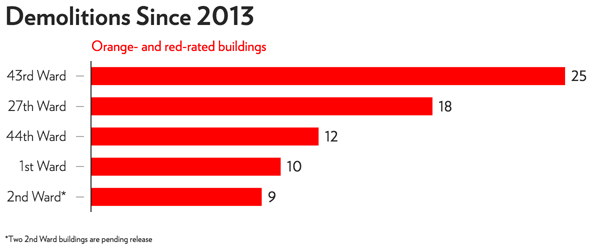In the West Loop, excavators can still be seen at the site of what was just a few weeks ago a rare industrial building designed by D. H. Burnham & Company, the storied firm led by Daniel Burnham, the legendary Chicago city planner and lead architect for the 1893 World’s Fair. Built over 100 years ago, the three-story masonry building at 1217-1227 W. Washington Boulevard was unceremoniously demolished in April, with its elaborate ornamentation and glazed brick reduced to a pile of rubble.
Developers often harken back to Burnham’s famous “make no little plans” screed when unveiling new proposals for Chicago, but what are Burnham’s words worth when little to no value is attached to the buildings crafted by his firm? Despite the 2015 passage of a new landmark district in the area to protect buildings exactly like this one, the property somehow slipped through the cracks.
The West Loop is not alone however, as several other Chicago communities have seen one-of-a-kind neighborhood buildings demolished without much warning or fanfare this year.
Englewood’s South Side Masonic Temple, a broad-shouldered red brick structure with a near-identical twin in Logan Square, was abruptly razed in January, while buildings of historic nature in Humboldt Park, Edgewater, and along the North Branch have also been lost in recent months. Ongoing preservation battles have sprouted in Logan Square to ensure the future of a former synagogue and in Little Village, an effort to save the shuttered Crawford Station designed by Graham, Anderson, Probst & White is running out of steam and time.

The majority of these buildings were noted as being either architecturally or culturally significant in the Chicago Historic Resources Survey (CHRS), a comprehensive review and tally of historic buildings completed and published by the city in the mid-’90s. While a designation in the survey does not protect buildings from demolition, there are special privileges granted for particularly sensitive ones—such as a 90-day hold on demolition permits—to allow the city and preservationists to further investigate a structure’s historic characteristics and contributions.
The Historic Resources Survey grants a color designation for highlighted buildings, from green, signaling an entry of note, to orange and red, indicating the most significant structures. According to city records of where these more sensitive orange- and red-rated buildings have been demolished, wards that are seeing a major uptick in new development are also ones that are witnessing sometimes dramatic losses in their historic building stock.
Since 2013, there have been 165 entries made in the city’s demolition delay hold list, but not all of the structures listed have been demolished as some applications were eventually withdrawn or tabled. In addition, many of the demolition applications submitted this year are still pending release. However, the wards that have witnessed the most demolition of orange- and red-rated buildings cover neighborhoods such as Lincoln Park, Lakeview, the West Loop, and Logan Square.

The data helps to illustrate that Chicago’s neighborhoods are experiencing a true preservation crisis, says Ward Miller, executive director of Preservation Chicago. Despite the 90-day hold on demolition permits for buildings determined to be historic by the city, Miller says that some city council members have used aldermanic prerogative to fast-track the eventual destruction of significant structures. But more often than not, Miller says that communities and preservation advocates simply do not have enough time to line up a buyer or produce a plan for adaptive reuse when demolition threats surface.
“While three months may seem like an ample amount of time, we find that we’re often scrambling to find stewards for these buildings,” Miller says. “There are some structures that require a lot of conversation and attention—how do you do all of that in the middle of winter and in a three month time?”
Miller also suggests that new development and preservation don’t have to be mutually exclusive, but says that the Chicago Historic Resources Survey exists as a tool to help plan for a community’s future. However, neighborhood preservation advocates have been stretched beyond capacity in recent years, overburdened by frequent demolitions, says Miller.
“I think we’ve experienced that crisis for a number of years now, but idea of working within the framework of historic buildings and investing in them really does create a more complex, more beautiful idea that forces one to go back to the drawing board to get things right.”



